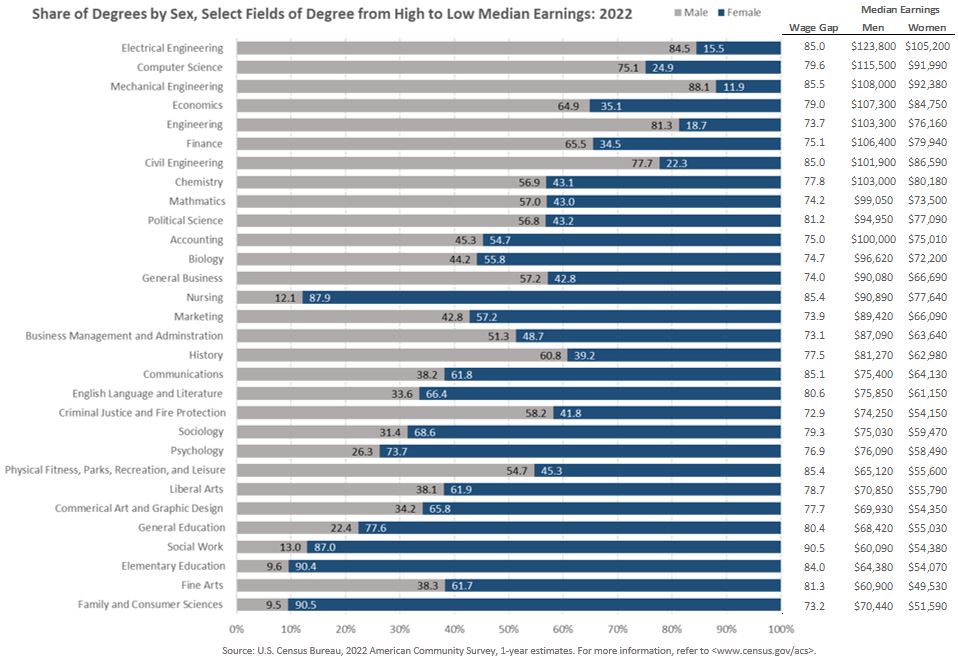Government, Money, Work
Education does not resolve gender wage gap according to data from the U.S. Census
Men earn more than women even when both have bachelor’s degrees in the same field, according to new data released by the U.S. Census Bureau. Women’s median earnings were 71% of men’s. The wage gap varied by field. Women earn less and are under-represented in high-earning fields that include engineering and finance. Women also earn less even in fields where women are highly over-represented such as education and nursing.

Higher education, a shift to higher-paying jobs, and more work experience have helped women narrow the gender pay age gap from 60% in 1980 to 83% in 2021. However, the gender wage gap still exists even as women outpace men in educational attainment. For graduates with a bachelor’s degrees or higher, women’s earnings were 71% of men’s for the same education across all fields per new data released by the U.S. Census Bureau.
The annual median earnings for all adults ages 25 to 65 with a bachelor’s degree or higher was $89,300 for men and $63,230 for women in 2022. The wage gap varied by field, ranging from under 71% to over 85%.
Women’s earnings were 71% of men’s earnings for the same education across all fields – much less than the 83% for all women.
Women are under-represented and earn less in high-earning fields
Women are under-represented and earn less in high-earning fields. For example, in the highest earning field, women hold less than 16% of electrical engineering degrees and have a median earning of $105,200 compared to $123,800 for men who hold the same degree.
Women earn less even in fields were women are over-represented
In fields where women are over-represented and even in low-earning fields, women earn less than men. For example, women hold over 90% of elementary education and have a median earning of $54,070 compared to $64,380 for men.

The wage gap is now between men and women in the same jobs
Social scientists for decades have been trying to identify factors contributing to the gender wage gap. Nobel Prize winner, Claudia Goldin, a Harvard University professor with an extensive career researching the gender wage gap, attributes the gap to factors ranging from discrimination to ‘greedy jobs’, jobs that pay more for working long hours and being on call that often penalize women.
Goldin has shown that much of the current wage gap is now between men and women in the same jobs and begins to appear after a woman has a child. Goldin says increasing government funding of childcare and making high-paying ‘greedy jobs’ so that people can share household and care-giving duties can help narrow the gap.
Increasing government funding of child care, making high-paying ‘greedy jobs’ less demanding, and progressing pay transparency can help narrow the gap.
Pay transparency can also narrow the wage gap
Other research have shown that the gender wage gap can disappear for most jobs and that a company’s bottom line can be improved when employers adopt transparent pay practices. Indeed, the global hiring platform, found employer-provided salary information in a majority of job listings in 2023 and expects pay transparency to climb. SHRM Research also reported that about 70% of organizations that list pay ranges in job listings found more people applying, and 66% found an increase of quality of applicants in their 2023 data.
Helpful Resources
Education Does Not Resolve Gender Wage Gap (U.S. Census)
Equal Pay Day: March 14, 2023 (U.S. Census)
Get a monthly dose of our latest insights!


About
myasianvoice
At MyAsianVoice, we connect Asian Americans to surveys and research to bridge the Asian data gap.
Join our growing respondent list >>

